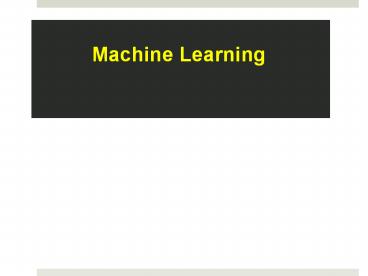Machine Learning Course in Hyderabad - PowerPoint PPT Presentation
Title:
Machine Learning Course in Hyderabad
Description:
ExcelR provides “Machine Learning Course” Training in Hyderabad. It has a top notch faculty who are more experienced . As Machine Learning Course is an Artificial Intelligence Learning Course ,it includes all the latest algorithms like ANN ,MLP,CNN and many more ,. You can get an in-depth understanding of Machine Learning Course and how it generates techniques to analyze structured and unstructured data . Practical case studies are done . This will help you to get master fundamentals.More then 60 assignments and 2 live projects . ExcelR is the better option for “Machine Learning Course” training – PowerPoint PPT presentation
Number of Views:35
Title: Machine Learning Course in Hyderabad
1
Machine Learning
2
Neural Networks
3
Understanding neural networks
An Artificial Neural Network (ANN) models the
relationship between a set of input signals and
an output signal using a model derived from
our understanding of how a biological brain
responds to stimuli from sensory inputs. Just as
a brain uses a network of interconnected cells
called neurons to create a massive parallel
processor, ANN uses a network of artificial
neurons or nodes to solve learning problems
The human brain is made up of about 85 billion
neurons, resulting in a network capable of
representing a tremendous amount of knowledge
For instance, a cat has roughly a billion
neurons, a mouse has about 75 million neurons,
and a cockroach has only about a million neurons.
In contrast, many ANNs contain far fewer neurons,
typically only several hundred, so we're in no
danger of creating an artificial brain anytime
in the near future
4
Biological to artificial neurons
Incoming signals are received by the cell's
dendrites through a biochemical process. The
process allows the impulse to be weighted
according to its relative importance
or frequency. As the cell body begins
accumulating the incoming signals, a threshold
is reached at which the cell fires and the output
signal is transmitted via an electrochemical
process down the axon. At the axon's terminals,
the electric signal is again processed as a
chemical signal to be passed to the neighbouring
neurons.
5
This directed network diagram defines
a relationship between the input signals received
by the dendrites (x variables), and the output
signal (y variable). Just as with the biological
neuron, each dendrite's signal is weighted (w
values) according to its importance. The
input signals are summed by the cell body and the
signal is passed on according to an activation
function denoted by f
A typical artificial neuron with n input
dendrites can be represented by the formula that
follows. The w weights allow each of the n inputs
(denoted by xi) to contribute a greater or lesser
amount to the sum of input signals. The net total
is used by the activation function f(x), and the
resulting signal, y(x), is the output axon
6
In biological sense, the activation function
could be imagined as a process that involves
summing the total input signal and determining
whether it meets the firing threshold. If so, the
neuron passes on the signal otherwise, it
does nothing. In ANN terms, this is known as a
threshold activation function, as it results in
an output signal only once a specified input
threshold has been attained
The following figure depicts a typical threshold
function in this case, the neuron fires when the
sum of input signals is at least zero. Because
its shape resembles a stair, it is sometimes
called a unit step activation function
7
Network topology
The ability of a neural network to learn is
rooted in its topology, or the patterns and
structures of interconnected neurons
key characteristics
The number of layers Whether information in
the network is allowed to travel backward The
number of nodes within each layer of the network
8
Number of layers
The input and output nodes are arranged in groups
known as layers
Input nodes process the incoming data exactly as
it is received, the network has only one set of
connection weights (labeled here as w1, w2, and
w3). It is therefore termed a single-layer network
9
Support Vector Machines
10
A Support Vector Machine (SVM) can be imagined as
a surface that creates a boundary between points
of data plotted in multidimensional that
represent examples and their feature values
The goal of a SVM is to create a flat boundary
called a hyperplane, which divides the space to
create fairly homogeneous partitions on either
side
SVMs can be adapted for use with nearly any type
of learning task, including both classification
and numeric prediction
11
Classification with hyper planes
For example, the following figure depicts
hyperplanes that separate groups of circles and
squares in two and three dimensions. Because the
circles and squares can be separated perfectly by
the straight line or flat surface, they are said
to be linearly separable
12
Which is the best Fit!
In two dimensions, the task of the SVM algorithm
is to identify a line that separates the two
classes. As shown in the following figure, there
is more than one choice of dividing line between
the groups of circles and squares. How does the
algorithm choose
13
Using kernels for non-linear spaces
A key feature of SVMs is their ability to map the
problem into a higher dimension space using a
process known as the kernel trick. In doing so, a
nonlinear relationship may suddenly appear to be
quite linear.
After the kernel trick has been applied, we look
at the data through the lens of a new dimension
altitude. With the addition of this feature, the
classes are now perfectly linearly separable
14
Thank you

